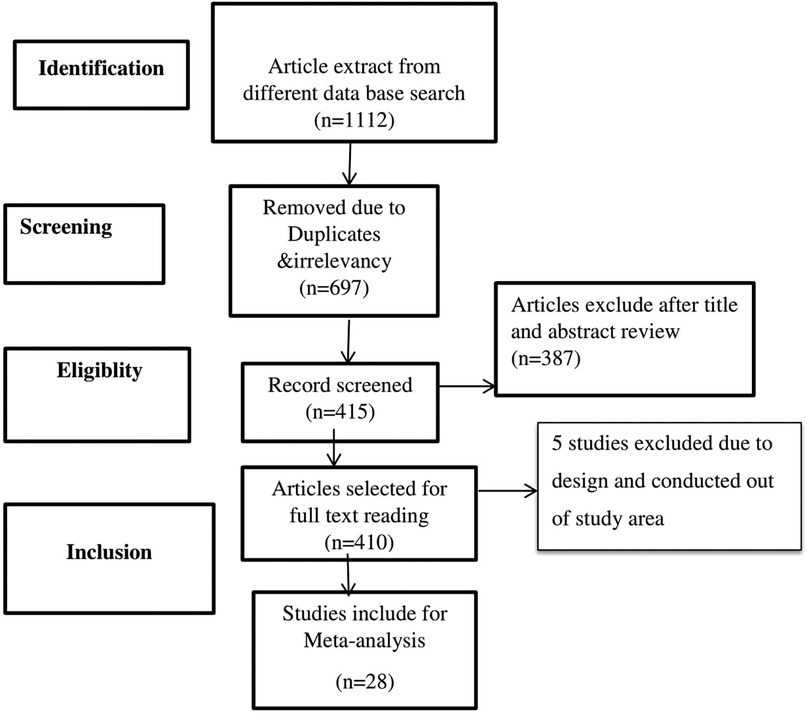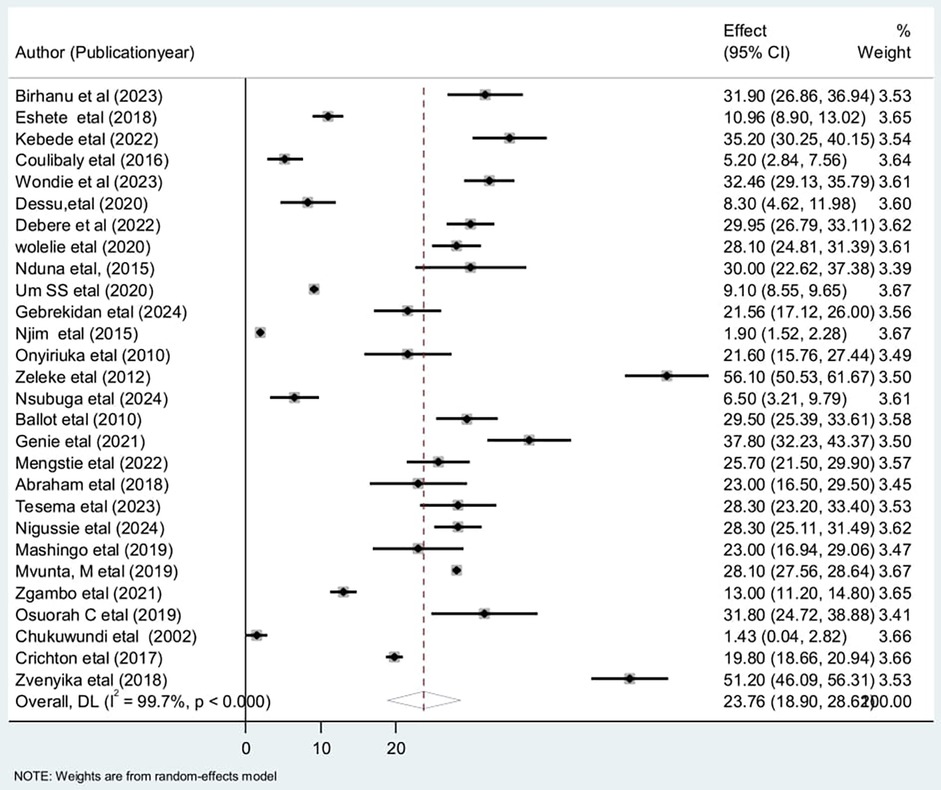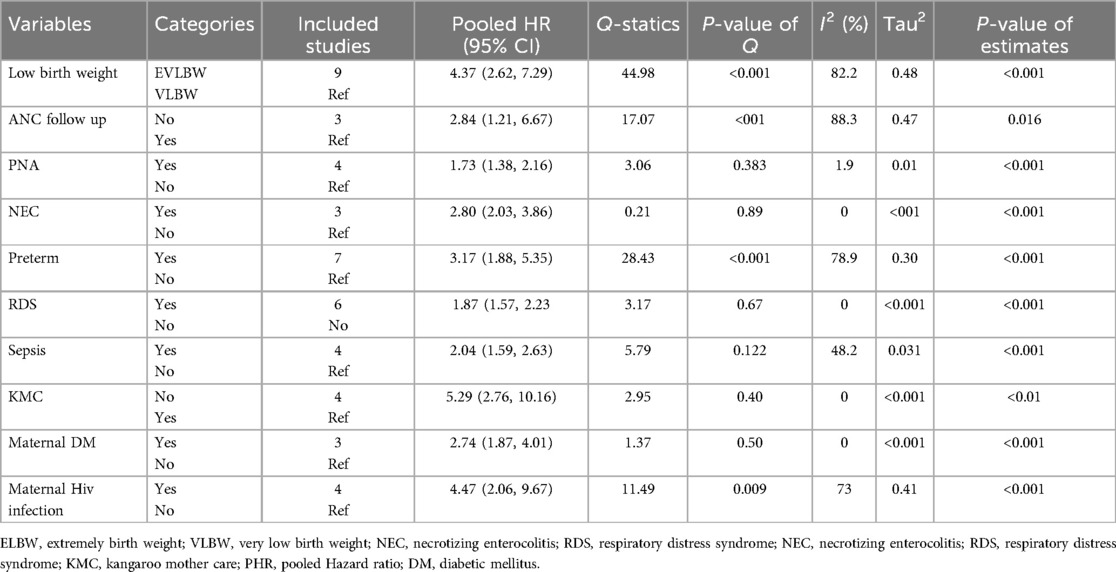- 1School of Nursing and Midwifery, Asrat Woldeyes Health Sciences Campus, Debre Berhan University, Debre Berhan, Ethiopia
- 2Department of Nursing, College of Health Science, Bulehora University, Bulehora, Ethiopia
Background: In Africa, the burden of low birth weight (LBW) neonatal mortality remains substantial, yet comprehensive evidence is lacking, with varied and inconclusive findings from primary studies. This systematic review and meta-analysis aimed to assess the pooled incidence and predictors of LBW neonatal mortality in Africa.
Methods: In accordance with the Preferred Reporting Items for Systematic Reviews and Meta-Analyses (PRISMA) guidelines, we systematically searched PubMed, EMBASE, Cochrane Library, African Journals Online, Web of Science, Google Scholar, and Google for relevant studies. The Newcastle Ottawa Scale was used to assess study quality. Heterogeneity and publication bias were evaluated using the I2 statistic and Egger's test. A random-effects model was applied due to significant heterogeneity, with pooled incidence and 95% confidence intervals (CIs) calculated. Subgroup and sensitivity analyses explored sources of heterogeneity.
Results: This meta-analysis included 28 studies involving 56,775 LBW neonates. The pooled incidence of LBW neonatal mortality in Africa was 33.1% per 100 person-years (95% CI: 19.54–46.65), with substantial heterogeneity (I2 = 99.9%, P < 0.001). Predictors associated with LBW neonatal mortality included extremely low birth weight (PHR = 4.37, 95% CI: 2.62–7.29), lack of antenatal care follow-up (PHR = 2.84, 95% CI: 1.21–6.67), perinatal asphyxia (PHR = 1.73, 95% CI: 1.38–2.16), necrotizing enterocolitis (PHR = 2.80, 95% CI: 2.03–3.86), preterm birth (PHR = 3.17, 95% CI: 1.88–5.35), respiratory distress syndrome (PHR = 1.87, 95% CI: 1.57–2.23), sepsis (PHR = 2.04, 95% CI: 1.59–2.63), lack of kangaroo mother care (PHR = 5.29, 95% CI: 2.76–10.16), maternal diabetes mellitus (PHR = 2.74, 95% CI: 1.87–4.01), and maternal HIV infection (PHR = 4.47, 95% CI: 2.06–9.67).
Conclusions: This study highlights a concerning high incidence of LBW neonatal mortality in Africa. Strategies targeting these predictors, such as improving antenatal care, promoting kangaroo mother care, and managing maternal health conditions like diabetes and HIV, could substantially reduce LBW neonatal mortality in the region. Policymakers and healthcare providers should prioritize these interventions to mitigate the high burden of LBW neonatal mortality and improve neonatal health outcomes across Africa.
Systematic Review Registration: identifier, CRD42024560375.
Introduction
Low birth weight (LBW), defined as birth weight of less than 2,500 g, remains a significant global public health challenge, particularly in Africa. Comprehending the Incidence and Predictors of Mortality in LBW Neonates in Africa is critical for developing effective health interventions and policies to improve neonatal outcomes (1, 2).
Low birth weight (LBW) remains a leading cause of neonatal morbidity and mortality globally, with a disproportionate burden borne by low- and middle-income countries (LMICs) (3).
According to the World Health Organisation (WHO), LBW affects approximately 15%–20% of all births worldwide, with a higher prevalence observed in low- and middle-income countries (LMICs), including those in Africa (4). Africa's distinct sociocultural and economic context marked by widespread maternal undernutrition (5), inadequate access to quality perinatal care (6), and persistent healthcare system inequities significantly contributes to the high burden of low birth weight (LBW)-related mortality (7).
Several studies have identified various predictors of mortality among LBW neonates, including prematurity, infections, birth asphyxia, and limited access to quality maternal and neonatal care (8, 9). Socioeconomic determinants such as maternal education, income level, and access to healthcare services also play crucial roles in neonatal survival (10).
Despite these findings, the incidence and predictors of mortality among low birth weight neonates differ significantly across various countries in Africa, highlighting the need for a region-specific synthesis of existing research. Therefore, this systematic review and meta-analysis aimed to determine the incidence of mortality among LBW neonates in Africa and to identify key predictors.
Research question
What is the pooled incidence of mortality among low birth weight (LBW) neonates in Africa?
What are the main predictors associated with mortality among LBW neonates in African countries?
Methods
Prospero registration and reporting
This systematic review and meta-analysis has been registered in the international prospective registry of Prospero with registration number (CRD42024560375). This review has been reported in accordance with the preferred Items for Systematic Review and Meta-Analysis (PRISMA 20 statement) guideline Supplementary File 1 (11).
Eligibility criteria
The inclusion criteria will follow the CoCoPop mnemonic (Condition, Context, and Population) since this review aims to evaluate incidence data.
Population: Low birth weight neonates
Condition: This systematic review considered studies that report on the prevalence and/or incidence, contributing factors, and outcomes of the specified condition.
Context: This systematic review and meta-analysis will include studies conducted in Africa.
Types of studies: Cohort studies from clinical and community-based settings reporting the incidence density rates of neonatal mortality and predictors using a hazard function were included.
Language: We considered articles published in the English language
Publication status: This review considered both unpublished and published articles from 2002 to 2024GC were included for analysis.
However, studies that did not report either the incidence density rate or predictors of neonatal mortality based on survival analysis principles or hazard functions were excluded. The EndNote X7 reference manager was used to organise the retrieved articles.
Search strategy
Eligible studies were selected through a tiered process: initially by titles, followed by abstracts, and finally by full-text articles, all based on the inclusion criteria. Primary studies were identified through searches in the Cochrane Library, PubMed, CINAHL,Scopus EMBASE, HINARI, Google Scholar, and Google. Search terms were used both individually and in combination with Boolean operators, “AND” and “OR”.In addition, after the identification of included studies, cross-references were searched to identify more eligible studies.
(Incidence OR “epidemiology” OR Occurrence OR Outcome OR Magnitude OR Prevalence OR Burden OR Proportion) AND (Mortality OR Death OR Fatality rate OR Survival OR “Survival rate” OR “Time to death”) AND (Predictors OR “Associated factors” OR Determinant OR “Risk factors”) AND (“Low birth weight neonates” OR “Low birth weight infants” OR “Low birth weight new born” OR “Very low birth weight neonates” OR “Extremely low birth weight neonates” OR “Small birth weight neonates”OR “Small for gestation age” OR “Small birth weight babies” OR “Small birth weight infants” OR “Small birth weight newborns” OR “Underweight neonates” OR “Below average birth weight neonates”) AND (“Africa”) were used for searching of literature.
Screening and data extraction
Two reviewers (LAM, WA) screened titles and abstracts against the inclusion criteria. Then, the full texts of articles were examined, by LAM, BG, YAD and MT independently. Discrepancies between reviewers were resolved through discussion.
The required data was extracted from a standard Microsoft Excel spreadsheet. For the incidence “The author's name, publication year, country, study design, sampling technique, sample size, response rate, incidence rate, and quality score were the key data types extracted. Moreover, Author name, publication year, hazard ratio (HR), lower confidence interval (LCI), and upper confidence interval (UCI) were extracted to identify predictors of low birth weight neonatal mortality.
Assessment of study quality
The Newcastle-Ottawa Scale (NOS) was utilized to evaluate the quality of the studies (12). LAM, WZ,AYB,MT and BG independently evaluated the quality of each included study using the appropriate appraisal tools, and any discrepancies were resolved through discussion.
the studies using this tool, considering aspects such as selection criteria, comparability, and the methodology employed for outcome determination. Studies scoring a minimum of 6 out of 10 on the Newcastle-Ottawa Scale were included in this review and meta-analysis. Although the Newcastle-Ottawa Scale (NOS) was used to assess study quality, no study was excluded based on a NOS score of less than 6.
Effect measures
In this review and meta-analysis, we evaluated the pooled incidence of LBW neonatal mortality, which was calculated by dividing the number of low birth weight neonates who died by the total number of person-year observations. The second objective was to assess the predictors of mortality among low birth weight neonates in Africa. In this review and meta-analysis, factors identified as determinants in at least three studies were included in meta-analysis. The pooled effect was expressed using the Hazard ratio (HR).
Data synthesis methods
In this study, the heterogeneity among the collected data was evaluated using the I2 test. It was then categorised into three levels: low (up to 50%), moderate (50%–75%), and high (over 75%) (13). We used STATA version 14 for analysis and a random effects model was used because of the significant variability observed among the studies. To further examine this variability and potential publication bias, we conducted the I2 test for heterogeneity and Egger's test for publication bias. The substantial heterogeneity among the studies warranted the use of a random effects model. we constructed a funnel plot to visually inspect the distribution of studies and detect potential publication bias. Subgroup and sensitivity analyses were performed to identify the sources of heterogeneity. The result of this meta-analysis was presented using figures and tables.
Results
In this systematic review and meta-analysis, 56,775 populations were included.
Study search and selection
We searched full-text primary studies conducted on human beings and published in the English language until now. Atotal of 1,112 primary articles were reviewed from PubMed, EMBASE, Cochrane Library, African Journal of Online, Web of Science, Google Scholar databases, and Google. Of these, 697 articles were excluded because of duplication, and 387 were excluded based on their title and abstracts.Moreover 5 studies were excluded due to different in study design and conducted out of study area. Lastly, 28 articles that met the inclusion criteria were selected for this meta-analysis (Figure 1).
Characteristics of included studies
This systematic review and meta-analysis included 28 primary studies. The total population of the included studies was 56,775 participants. All the studies included in this review utilized a cohort study design.
From these 16 studies were a retrospective cohort. Half of the studies (14) were conducted in Ethiopia (14–22). Three of the studies were conducted in Nigeria (23–25). Two studies from Malawi (26, 27), and Another two studies were conducted in South Africa (28, 29). The rest, Zambia (30), Burkinafaso (31), Tanzania (24), Zimbabwe (32),Cameron (29, 33) and Uganda (34), with one study from each country. More than half of the included studies (15) utilized a simple random sampling technique (Table 1).
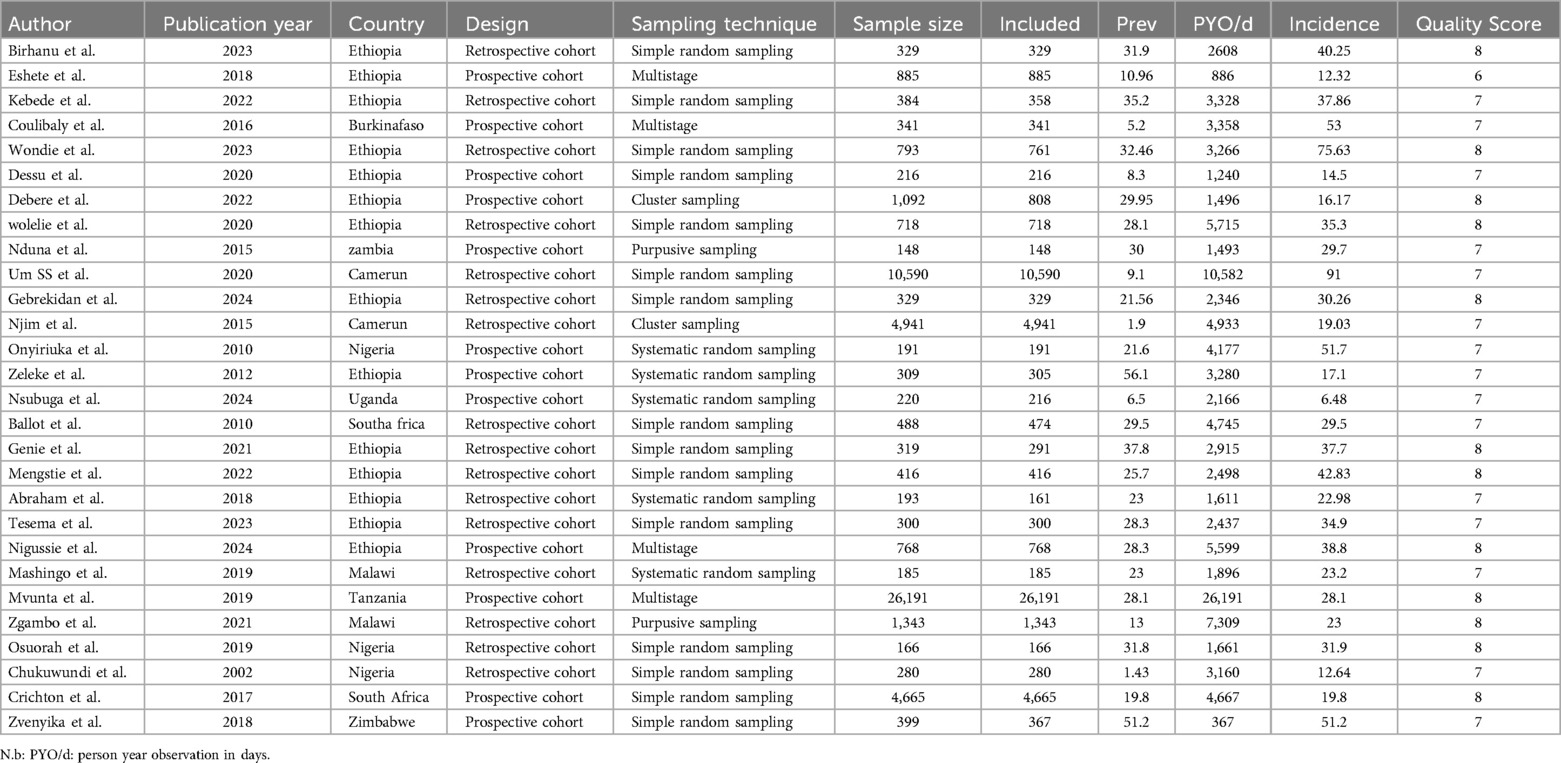
Table 1. Characteristics of the included studies on incidence and predictor of low birth weight neonatal mortality in Africa, 2024 (N = 28).
Results of syntheses and reporting bias
A forest plot was done to display the outcomes of the included 1 studies. This systematic review and meta-analysis comprised 28 primary studies to estimate the pooled incidence of mortality among low birth weight (LBW) neonates. In the present systematic review and meta-analysis, the pooled incidence of mortality among low birth weight neonates in Africa was 33.1%, (95% CI: 19.54–46.65) per 100 per year observation (Figure 2).
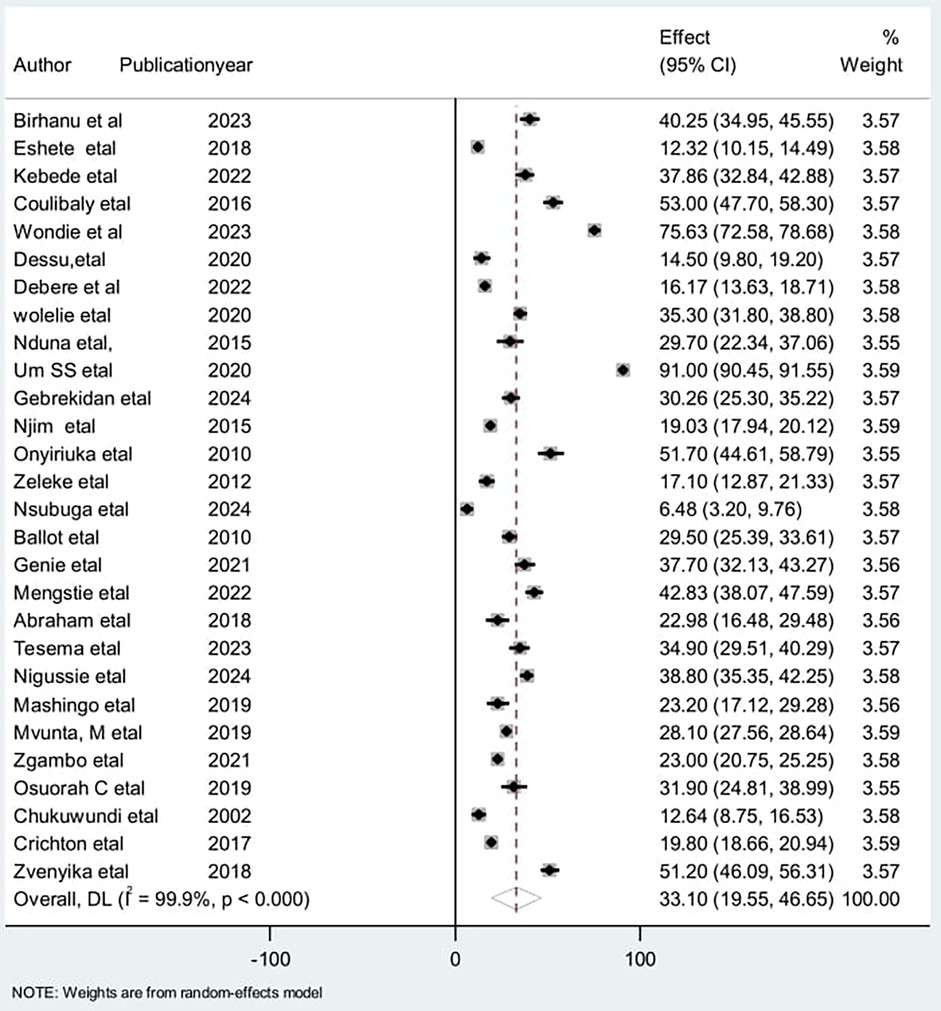
Figure 2. Forest plot for the incidence of low birth weight neonatal mortality in Africa, 2024 (n = 28).
A total of 23.75% (95% CI: 18.89, 28.62) of the participants died during the follow-up period (Figure 3).
The presence of heterogeneity and publication bias was evaluated within the included studies. There was significant heterogeneity across the studies in this meta-analysis (I2 = 99.9%, p < 0.001). There was no publication bias among the included studies, even though the funnel plot shows an asymmetrical distribution (Figure 4). However, Egger's test did not indicate a statistically significant presence of publication bias (p = 0.143).
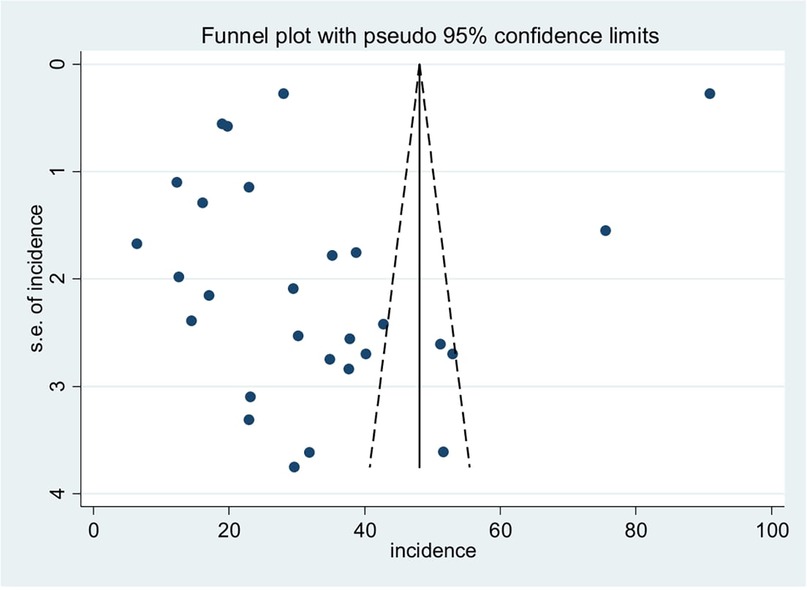
Figure 4. Funnel plot for the incidence of low birth weight neonatal mortality and its predictor in Africa.
To assess the source of heterogeneity, a subgroup analysis was conducted based on the study area, study design, and sampling technique. Studies conducted in Cameroon had a high incidence of low birth weight neonatal mortality [55.1: 95% CI: (15.51–125.54)] and heterogeneity (I2 = 100% with p < 0.01), compared to studies conducted in other countries (Figure 5). Regarding the subgroup analysis on sampling design, there was a high incidence among studies on retrospective cohorts [36.76; 95% CI: (15.46–58.06)] and high heterogeneity (I2 = 99.9% with p < 0.001) (Figure 6). Additionally, there was a high incidence of mortality among studies with a simple random sampling technique [39.1: 95% CI: (17.19–60.87)] and high heterogeneity (I2 = 99.9% with p < 0.001) (Figure 7). Finally, a sensitivity analysis was conducted and revealed that no single study affect the pooled incidence rate (Figure 8).
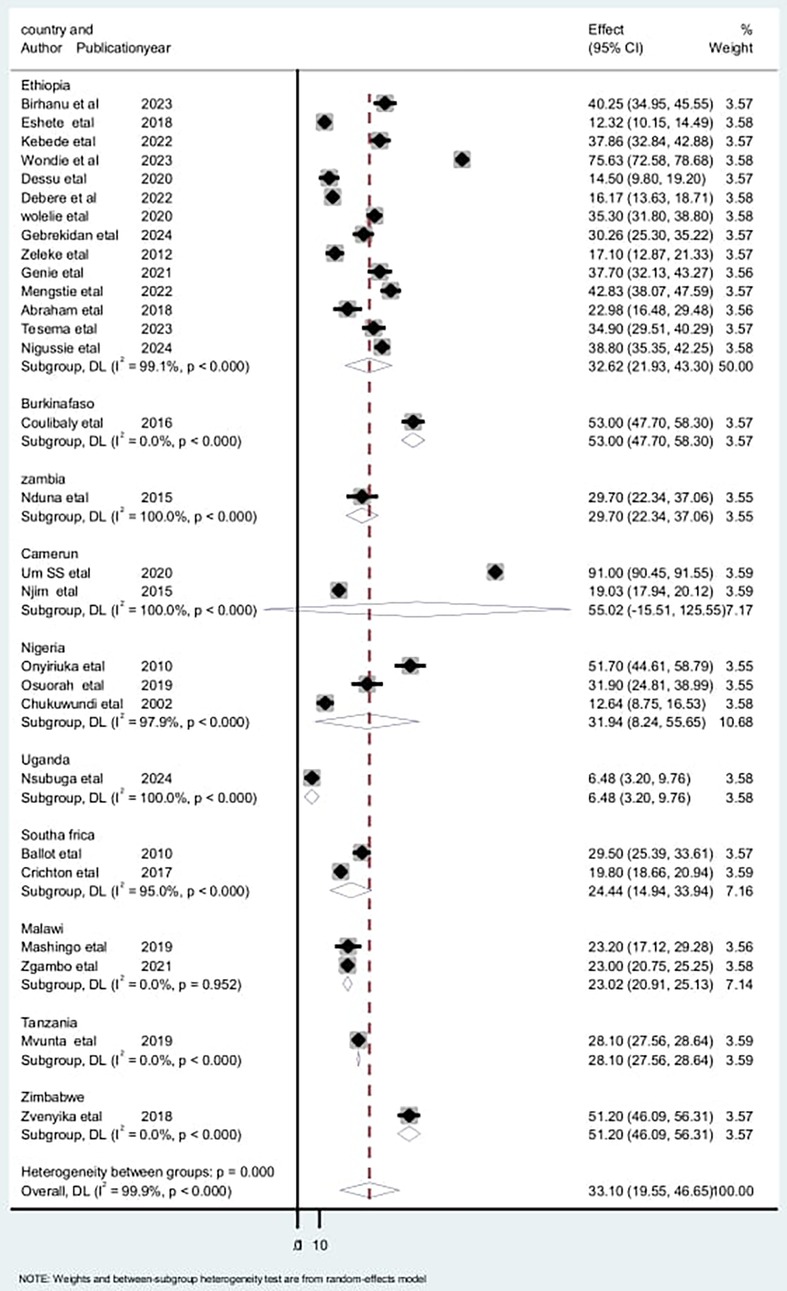
Figure 5. Subgroup analysis by countries for the included studies to investigate the source of heterogeneity among studies conducted in Africa, 2024 (n = 28).
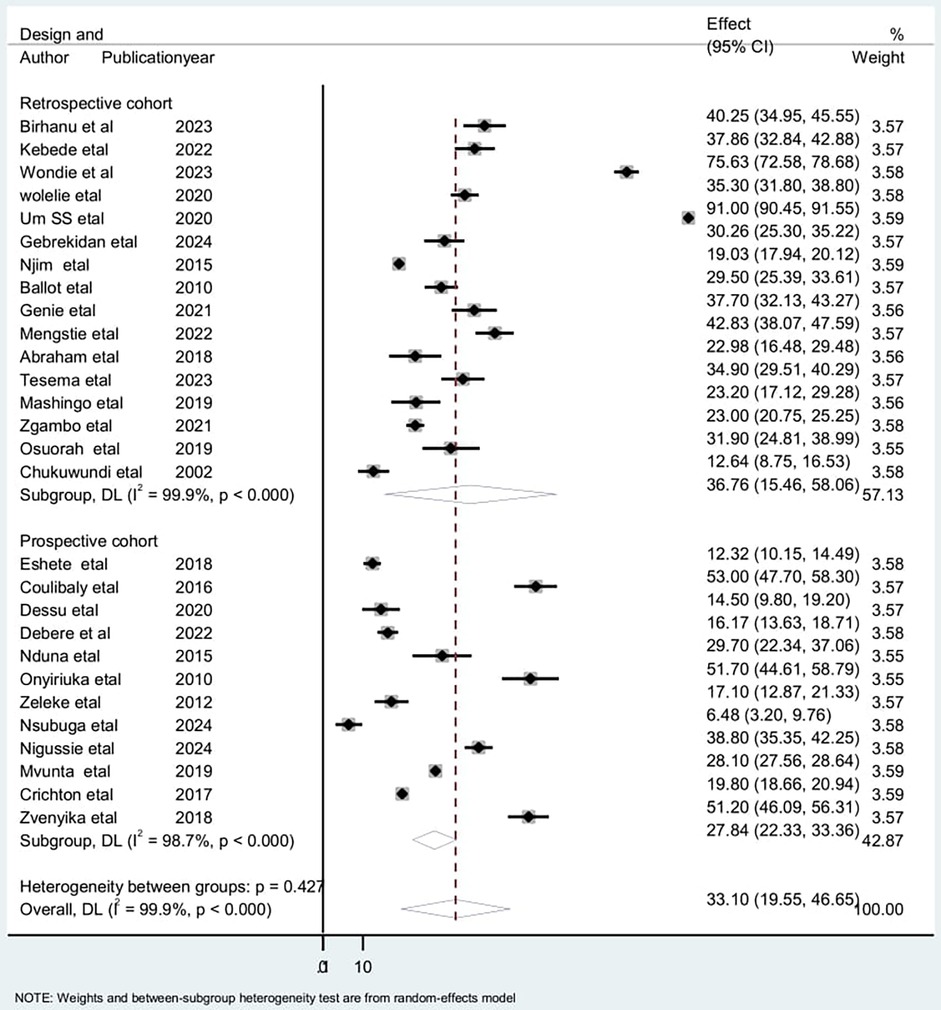
Figure 6. Sub group analysis by study design for the included studies to investigate the source of heterogeneity among studies conducted in Africa, 2024 (n = 28).
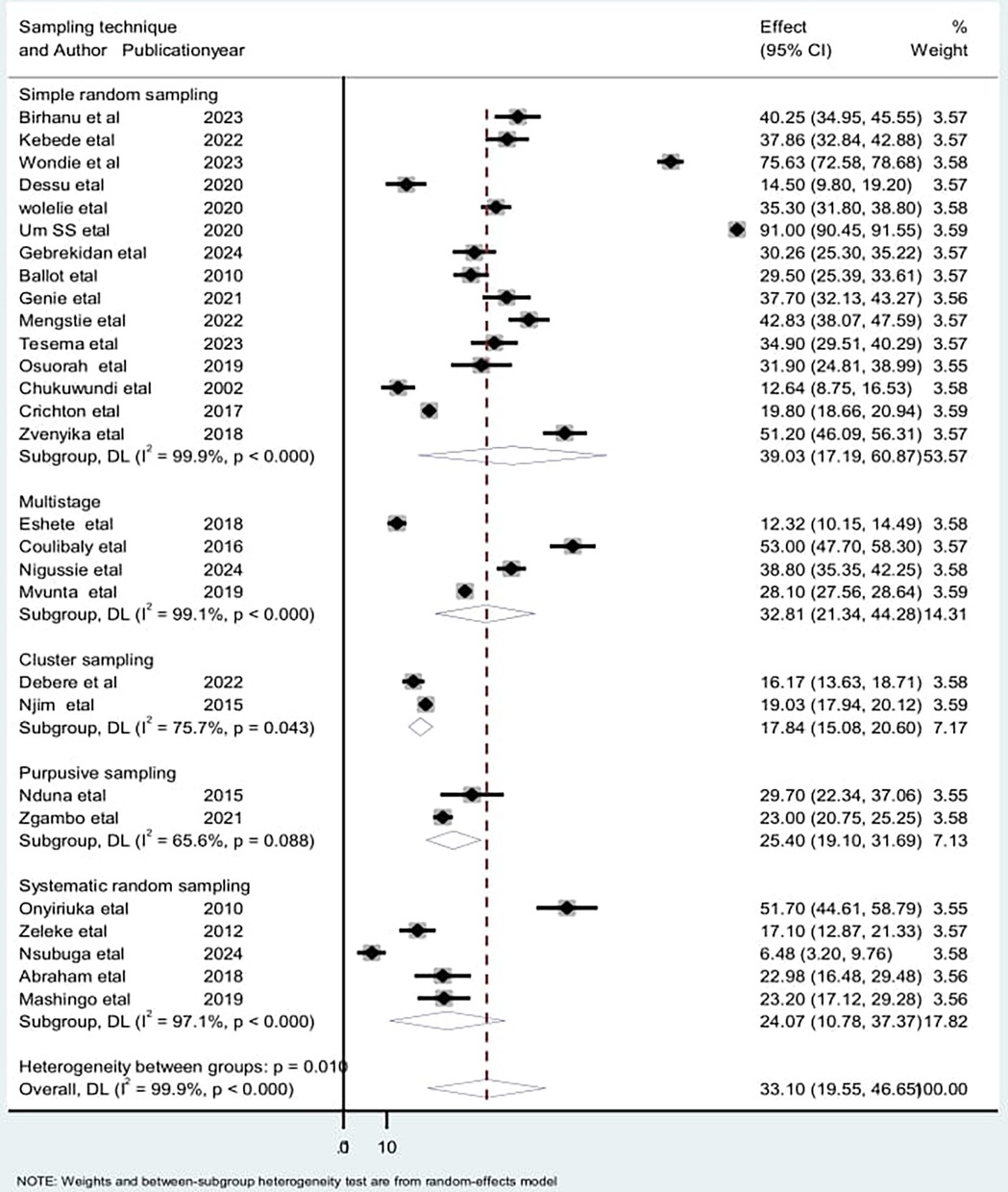
Figure 7. Sub group analysis by sampling technique for the included studies to investigate the source of heterogeneity among studies conducted in Africa, 2024 (n = 28).
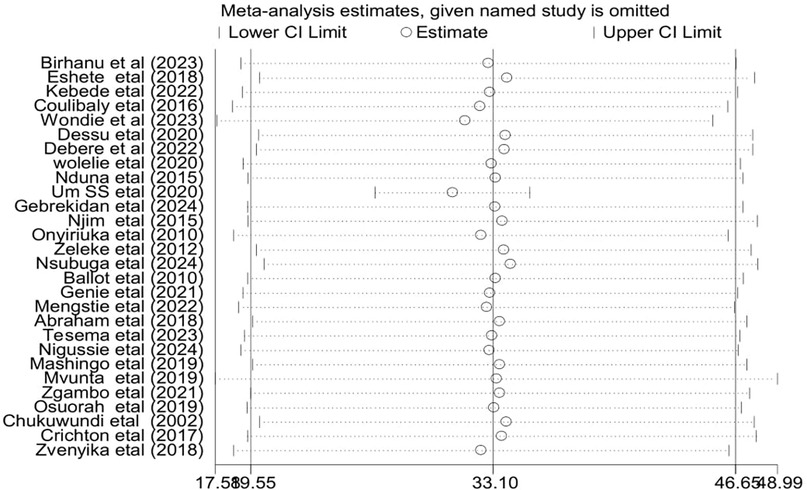
Figure 8. Sensitivity analysis for studies included to estimate the pooled incidence of low birth weight neonatal mortality in Africa.
Predictor of mortality
A total of 28 studies were analyzed to estimate the pooled hazard ratio for predictors of mortality among low birth weight neonates.
In this study, LBW neonates with extremely very low birth weight (EVLBW) had a 4.3-fold higher risk of mortality compared to their counterparts (PHR = 4.37; 95% CI: 2.62–7.29) (14–16, 19, 35, 36). LBW neonates with perinatal asphyxia (PNA) had a 1.73 fold higher risk of mortality compared to neonates without PNA. (PHR = 1.73, 95%: CI: 1.38–2.16) (14, 16, 21, 26). Similarly, LBW neonates with respiratory distress syndrome (RDS) had a 1.87-fold higher risk of mortality (PHR = 1.87, 95% CI: 1.57, 2.23) (16, 16, 18, 26, 36, 37).
LBW neonates whose mothers had no antenatal care (ANC) follow-up had a 2.84-fold higher risk of mortality compared to their counterparts. (PHR = 2.84, 95% CI: 1.21, 6.67) (15, 22, 24). Similarly, LBW neonates with necrotizing enterocolitis (NEC) had a 2.8 fold higher risk of mortality compared to their counterparts (PHR = 2.80, 95% CI: 12.03, 3.86) (16, 16, 18). Moreover, LBW neonates born preterm had a 3.1-fold higher risk of mortality compared to those born at term (PHR = 3.1; 95% CI: 1.88–5.35) (14–16, 19, 21, 36, 38, 39). The likelihood of LBW neonates with sepsis had a 2.04 time higher risk of death (PHR = 2.04, 95% CI: 1.59, 2.63).
This review also demonstrated that LBW neonates whose mothers did not receive kangaroo mother care (KMC) were at a 5.29 times higher risk of mortality compared to their counterparts (PHR = 5.29, 95% CI: 2.76, 10.16) (14, 17, 40).
Low-birth weight neonates born to mothers with diabetes mellitus (DM) had a 2.7 times higher risk of mortality compared to their counterparts (PHR = 1.87, 4.01, 95%) (17, 36).
LBW neonates from mothers with HIV were 4.4 times more hazardous to die than mothers without HIV (PHR: 4.47, 95% CI: 2.06, 9.67) (17, 22, 24, 36) (Table 2).
Discussion
The pooled mortality rate among low birth weight (LBW) neonates in Africa was 33.1% (95% CI: 19.54–46.65) per 100 person-years. This result aligns with studies from Ethiopia, where the neonatal mortality rate for LBW infants has been reported to be approximately 30% (41), and in Nigeria, the neonatal mortality rate for LBW 35%–40% (42). This consistency suggests that certain regions within Africa share similar healthcare challenges and resource limitations.
This review and meta-analysis found higher mortality rates in Africa compared to high-income countries. In the United States, the rate is 5%–10% per 100 person-years (43), Sweden, it is about 4% (44), in South Africa, the neonatal mortality rate for LBW infants is about 20% (45). In Egypt, the rate is around 25% (46). This disparity is might be because of the advanced healthcare system differences, including the availability of neonatal intensive care units (NICUs) and universal healthcare access,and comprehensive prenatal and postnatal care, including routine screenings and early interventions, in high-income countries.
Healthcare system differences, including the availability of neonatal intensive care units (NICUs) and universal healthcare access.However, this finding is less than a study conducted in Bangladesh, which reported a rate of 11.2 per 100 neonate days (95% CI: 9.1–136.) (47). The variation might be due to differences in healthcare infrastructure, socioeconomic conditions, and possibly more effective maternal and child health programs.
This review identified various factors associated with mortality among low birth weight neonates. Neonates born with extremely low birth weight were found to face a four fold higher risk of mortality compared to those born with normal birth weight.
This finding in line with research conducted in Brazil (48), in England (49), India (50), Ethiopia (18) Ethiopia (15), Pakistan (51), Zimbabwe (32). This may occur because lower birth weight makes neonates more vulnerable to infections, hypothermia, and hypoglycaemia, increasing their risk of mortality.
Additionally, low birth weight (LBW) neonates with perinatal asphyxia (PNA) had nearly twice the risk of mortality compared to those without PNA. This observation aligns with findings from research conducted in Brazil (52), India (50), and Bangladish (53). This might be due to attributed to perinatal asphyxia (PNA), which results in oxygen deprivation, leading to progressive hypoxemia and hypercapnia. This condition can lead to harm in the central nervous system and other organs. In this review and meta-analysis, neonates diagnosed with Respiratory Distress Syndrome (RDS) were nearly two times higher risk of death as compared to their counterparts. This result is consistent with findings in Brazil (54), Zimbabwe (32), India (50, 55), and Ethiopia (18). Due to a significant number of neonates being born prematurely, their lungs may experience inadequate surfactant production, leading to frequent instances of collapsed lungs and respiratory failure.
Moreover, in this review, the risk of mortality among low-birth-weight newborns with NEC was nearly three times as high as that of their counterparts.This finding is consistent with a study conducted in, south Africa (28), and Brazil (54). This study shows that most subjects were preterm, making them susceptible to gastrointestinal immaturity in motility, digestive function, circulatory regulation, barrier protection, and immune defense, which increases the risk of death.
In this review, preterm low-birth-weight (LBW) neonates had a higher risk of death compared to their counterparts. This finding is consistent with studies conducted in Bangladesh (56), Burkina Faso (57), and Cuiaba (58). This is because premature neonates have an immature immune system, less adipose tissue, and incomplete organ development, making them more susceptible to complications that can lead to death.
The study found that low-birth-weight (LBW) neonates diagnosed with sepsis had a higher mortality rate compared to their counterparts. This result is supported by studies conducted in Odisha, India (58), Bahirdar (18, 57–59), and Northern India (18, 58–61). This could be due to the fact that sepsis markedly raises the likelihood of mortality. Low-birth-weight (LBW) neonates born to mothers with a history of HIV had more than four times higher risk of death compared to those born to HIV-negative mothers. This finding aligns with a study conducted in Southern Ethiopia (61). This increased risk may be due to maternal immune compromise, which limits breastfeeding and increases medical costs.
Neonates with low birth weight born from mothers with a history of diabetes mellitus had nearly three times higher risk of mortality compared to those who had not. This finding is consistent with a study conducted in southern Ethiopia (15, 17). The increased risk may be related to complications of diabetes mellitus during pregnancy, such as hypoglycaemia, hypocalcemia, respiratory distress, growth restriction, polycythemia, elevated magnesium levels, congenital anomalies, and increased bilirubin levels (62, 63).
This review revealed that neonates with low birth weight who were not placed under kangaroo mother care within one hour of delivery had five times higher risk of mortality compared to their counterparts (17). This might be because of kangaroo mother care, which facilitates early and uninterrupted skin-to-skin contact between mother and baby, and encourages exclusive breastfeeding as recommended by the WHO (64).
LBW neonates whose mothers did not receive antenatal care (ANC) follow-up were almost three times more likely to die compared to those whose mothers received ANC. This result corresponds with findings from a study conducted in Brazil (65). This might be dueto mothers who receive regular antenatal care (ANC) are more likely to detect and manage potential health issues during pregnancy.
Limitation of the study
Most included studies were from a limited number of African countries (e.g., Ethiopia and Nigeria), which may affect the generalizability of the findings to the entire continent. Additionally, only studies published in English were included, which may have excluded relevant data. Furthermore, there was high heterogeneity among the included studies.
Conclusions and recommendations
This meta-analysis indicates a higher incidence of mortality among low birth weight neonates in Africa. Extremely low birth weight, lack of antenatal care, perinatal asphyxia, necrotizing enter colitis, preterm birth, respiratory distress syndrome, sepsis, lack of kangaroo mother care, maternal diabetes mellitus, and maternal HIV infection were predictors of LBW neonatal mortality.
Based on these findings, it is recommended to increasing ANC visit adherence per WHO guidelines. Additionally, healthcare protocols should prioritize early detection and intervention for conditions for perinatal asphyxia, necrotizing enterocolitis, and respiratory distress syndrome. Promoting kangaroo mother care practices is also crucial for improving outcomes of low birth weight neonates. Furthermore, systematic screening and effective management of maternal diabetes mellitus and HIV infection are essential to minimize neonatal mortality. Integrating these strategies into maternal and neonatal healthcare policies can effectively mitigate the risk factors associated with low birth weight neonatal mortality.
Moreover, this study highlights key predictors of LBW neonatal mortality, though heterogeneity limits the generalizability of findings. Future research should prioritize context-specific interventions, with a focus on targeted strategies like improving neonatal resuscitation training and expanding preterm birth prevention efforts.
Data availability statement
The original contributions presented in the study are included in the article/Supplementary Material, further inquiries can be directed to the corresponding author.
Author contributions
LM: Conceptualization, Formal analysis, Methodology, Software, Writing – original draft. WT: Conceptualization, Supervision, Validation, Writing – review & editing. MT: Conceptualization, Supervision, Validation, Visualization, Writing – review & editing. WA: Conceptualization, Supervision, Validation, Writing – review & editing. AB: Supervision, Visualization, Writing – review & editing. YD: Conceptualization, Supervision, Writing – review & editing. MT: Conceptualization, Data curation, Validation, Writing – review & editing. BG: Investigation, Supervision, Validation, Writing – review & editing.
Funding
The author(s) declare that no financial support was received for the research and/or publication of this article.
Acknowledgments
We would like to acknowledge all the authors.
Conflict of interest
The authors declare that the research was conducted in the absence of any commercial or financial relationships that could be construed as a potential conflict of interest.
Publisher's note
All claims expressed in this article are solely those of the authors and do not necessarily represent those of their affiliated organizations, or those of the publisher, the editors and the reviewers. Any product that may be evaluated in this article, or claim that may be made by its manufacturer, is not guaranteed or endorsed by the publisher.
Supplementary material
The Supplementary Material for this article can be found online at: https://www.frontiersin.org/articles/10.3389/fped.2025.1458871/full#supplementary-material
References
1. Sutan R, Mohtar M, Mahat AN, Tamil AM. Determinant of low birth weight infants: a matched case control study. Open J Prev Med. (2014) 4(3):91–9. doi: 10.4236/ojpm.2014.43013
3. Geberu DM, Baffa LD, Hagos A, Tiruneh MG, Teshale G, Tafere TZ, et al. Pooled prevalence and factors of low birth weight among newborns in the top 20 countries with the highest infant mortality: analysis of recent demographic and health surveys. BMJ Open. (2025) 15(4):e098090. doi: 10.1136/bmjopen-2024-098090
4. Fleischer NL, Merialdi M, van Donkelaar A, Vadillo-Ortega F, Martin RV, Betran AP, et al. Outdoor air pollution, preterm birth, and low birth weight: analysis of the world health organization global survey on maternal and perinatal health. Environ Health Perspect. (2014) 122(4):425–30. doi: 10.1289/ehp.1306837
5. Black RE, Victora CG, Walker SP, Bhutta ZA, Christian P, de Onis M, et al. Maternal and child undernutrition and overweight in low-income and middle-income countries. Lancet. (2013) 382(9890):427–51. doi: 10.1016/S0140-6736(13)60937-X
6. Lawn JE, Blencowe H, Oza S, You D, Lee AC, Waiswa P, et al. Every newborn: progress, priorities, and potential beyond survival. Lancet. (2014) 384(9938):189–205. doi: 10.1016/S0140-6736(14)60496-7
7. Kruk ME, Gage AD, Arsenault C, Jordan K, Leslie HH, Roder-DeWan S, et al. High-quality health systems in the sustainable development goals era: time for a revolution. Lancet Glob Health. (2018) 6(11):e1196–252. doi: 10.1016/S2214-109X(18)30386-3
8. Liu L, Oza S, Hogan D, Chu Y, Perin J, Zhu J, et al. Global, regional, and national causes of under-5 mortality in 2000–15: an updated systematic analysis with implications for the sustainable development goals. Lancet. (2016) 388(10063):3027–35. doi: 10.1016/S0140-6736(16)31593-8
9. Blencowe H, Cousens S, Chou D, Oestergaard M, Say L, Moller A-B, et al. Born too soon: the global epidemiology of 15 million preterm births. Reprod Health. (2013) 10(Suppl 1):S2. doi: 10.1186/1742-4755-10-S1-S2
10. Bhutta ZA, Das JK, Bahl R, Lawn JE, Salam RA, Paul VK, et al. Can available interventions end preventable deaths in mothers, newborn babies, and stillbirths, and at what cost? Lancet. (2014) 384(9940):347–70. doi: 10.1016/S0140-6736(14)60792-3
11. Page MJ, Moher D, Bossuyt PM, Boutron I, Hoffmann TC, Mulrow CD, et al. PRISMA 2020 Explanation and elaboration: updated guidance and exemplars for reporting systematic reviews. BMJ. (2021) 372:n160. doi: 10.1136/bmj.n160
12. Wells GA, Shea B, O’Connell D, Peterson J, Welch V, Losos M, et al. The Newcastle-Ottawa Scale (NOS) for assessing the quality of nonrandomised studies in meta-analyses.
13. Higgins JP, Thompson SG, Deeks JJ, Altman DG. Measuring inconsistency in meta-analyses. Br Med J. (2003) 327(7414):557–60. doi: 10.1136/bmj.327.7414.557
14. Birhanu D, Guadu J, Belege F, Moges N. Time to death and its predictors among low-birth weight neonates admitted in Addis Ababa, Ethiopia. J Pediatr Neonatal Biol. (2023) 8(2):201–12. doi: 10.33140/JPNB.08.02.06
15. Eshete A, Alemu A, Zerfu TA. Magnitude and risk of dying among low birth weight neonates in rural Ethiopia: a community-based cross-sectional study. Int J Pediatr. (2019) 2019(1):9034952. doi: 10.1155/2019/9034952
16. Wondie WT, Zeleke KA, Wubneh CA. Incidence and predictors of mortality among low birth weight neonates in the first week of life admitted to the neonatal intensive care unit in Northwestern Ethiopia comprehensive specialized hospitals, 2022. Multi-center institution-based retrospective follow-up study. BMC Pediatr. (2023) 23(1):489. doi: 10.1186/s12887-023-04319-0
17. Dessu S, Habte A, Mesele M. The kaplan meier estimates of mortality and its predictors among newborns admitted with low birth weight at public hospitals in Ethiopia. PLoS One. (2020) 15(9):e0238629. doi: 10.1371/journal.pone.0238629
18. Woelile TA, Kibret GT, Workie HM, Amare AT, Tigabu A, Aynalem YA, et al. Survival status and predictors of mortality among low-birth-weight neonates admitted to the neonatal intensive care unit at felege hiwot comprehensive specialized hospital, Bahir Dar, Ethiopia, 2020. Pediatric Health Med Ther. (2021) 12:451–66. doi: 10.2147/PHMT.S323526
19. Gebrekidan AB. Survival Status and Predictors of Mortality Among Low-birthweight Neonates Admitted to Neonatal Intensive Care Unit in Suhul General Hospital, Northern Ethiopia: A Retrospective Cohort Study [preprint]. Durham, NC: Research Square (2024). doi: 10.21203/rs.3.rs-4219427/v1
20. Genie YD, Kebede BF, Zerihun MS, Beyene DT. Morbidity and mortality patterns of preterm low birthweight neonates admitted to referral hospitals in the amhara region of Ethiopia: retrospective follow-up study. BMJ Open. (2022) 12(7):e054574. doi: 10.1136/bmjopen-2021-054574
21. Nigussie J, Girma B, Mulugeta T, Sibhat M, Molla A. Survival Status and predictors of mortality among low-birth-weight neonates in Southern Ethiopia: a prospective follow-up study. J Neonatol. (2024):09732179231226026. doi: 10.1177/09732179231226026
22. Zeleke BM, Zelalem M, Mohammed N. Incidence and correlates of low birth weight at a referral hospital in Northwest Ethiopia. Pan Afr Med J. (2012) 12:4. doi: 10.11604/pamj.2012.12.4.1284
23. Ekwochi U, Ifediora C, Osuorah CDI, Ndu IK, Asinobi I, Amadi OF, et al. Determinants of survival in low birth weight infants at a tertiary healthcare facility in the South Eastern Nigeria. J Exp Res. (2017) 5:1–7.
24. Mvunta MH, Mboya IB, Msuya SE, John B, Obure J, Mahande MJ. Incidence and recurrence risk of low birth weight in Northern Tanzania: a registry based study. PLoS One. (2019) 14(4):e0215768. doi: 10.1371/journal.pone.0215768
25. Onyiriuka A. Incidence of delivery of low birthweight infants in twin gestations. Niger J Clin Pract. (2010) 13(4):365–70. doi: 10.4103/1119-3077.74194
26. Zgambo AC. Survival of low Birth Weight Babies Admitted at District and Private Hospitals in Chiradzulu, Malawi: A Retrospective Cohort Study. Blantyre, Malawi: Kamuzu University of Health Sciences (2021).
27. Mashego M. Survival of very low birth and extreme low birth weight infants at Mankweng Neonatal Care Unit. (2019).
28. Ballot DE, Chirwa T, Ramdin T, Chirwa L, Mare I, Davies VA, et al. Comparison of morbidity and mortality of very low birth weight infants in a central hospital in Johannesburg between 2006/2007 and 2013. BMC Pediatr. (2015) 15:1–11. doi: 10.1186/s12887-015-0337-4
29. Njim T, Atashili J, Mbu R, Choukem S-P. Low birth weight in a sub-urban area of Cameroon: an analysis of the clinical cut-off, incidence, predictors and complications. BMC Pregnancy Childbirth. (2015) 15:1–8. doi: 10.1186/s12884-015-0723-9
30. Nduna B. Survival of Very Low Birth Weight Neonates Initiated on Early Versus Late Enteral Feeding at the University Teaching Hospital. Lusaka: The University of Zambia (2015).
31. Coulibaly A, Baguiya A, Millogo T, Meda IB, Koueta F, Kouanda S. Predictors of mortality of low birth weight newborns during the neonatal period: a cohort study in two health districts of Burkina Faso. Int J Gynaecol Obstet. (2016) 135:S89–92. doi: 10.1016/j.ijgo.2016.08.006
32. Zvenyika-Hlatywayo L, Chimhuya S, Gumbo F, Nyandoro G, Kambarami R. Risk factors for mortality in low birth weight infants at Harare hospital (maternity unit), Zimbabwe. Clin Pediatr Res. (2018) 2(1):33–41. doi: 10.36959/395/504
33. Um SSN, Kana SP, Njock VN, Abondo G, Koki PO. Mortality of low birth weight neonates in a tertiary care centre of Yaounde (Cameroon). Health Sci Dis. (2020) 21(2). https://www.hsd-fmsb.org/index.php/hsd/article/view/1828
34. Nsubuga R, Rujumba J, Nyende S, Kisaka S, Idro R, Nankunda J. Predictors of mortality among low birth weight neonates after hospital discharge in a low-resource setting: a case study in Uganda. PLoS One. (2024) 19(6):e0303454. doi: 10.1371/journal.pone.0303454
35. Woelile TA, Kerebeh G, Birrie E, Desalew A, Sintayehu Y, Teferi N, et al. Cause and predictors of neonatal mortality among neonates admitted to neonatal intensive care units of public hospitals in eastern Ethiopia: a facility-based prospective follow-up study. BMJ Open. (2020) 10(8):e038182. doi: 10.1136/bmjopen-2020-038182
36. Mengstie. Survival Status and Predictors of Mortality Among Low Birth Weight Neonates Admitted To Neonatal Intensive Care Unit In Public Hospitals, North Shoa Zone, Amhara National Regional State, Ethiopia. (2022).
37. Tesema GA, Worku MG, Teshale AB. Duration of birth interval and its predictors among reproductive-age women in Ethiopia: gompertz gamma shared frailty modeling. PLoS One. (2021) 16(2):e0247091. doi: 10.1371/journal.pone.0247091
38. Woelile TA, Kerebeh G, Birrie E, Shukla VV, Eggleston B, Ambalavanan N, et al. Predictive modeling for perinatal mortality in resource-limited settings. BMJ Open. (2020) 3(11):e2026750.
39. Ballot DE, Davies VA, Cooper PA, Chirwa T, Argent A, Mer M. Retrospective cross-sectional review of survival rates in critically ill children admitted to a combined paediatric/neonatal intensive care unit in Johannesburg, South Africa, 2013–2015. BMJ Open. (2016) 6(6):e010850. doi: 10.1136/bmjopen-2015-010850
40. Debere MK, Haile Mariam D, Ali A, Mekasha A, Chan GJ. Survival status and predictors of mortality among low-birthweight neonates admitted to KMC units of five public hospitals in Ethiopia: frailty survival regression model. PLoS One. (2022) 17(11):e0276291. doi: 10.1371/journal.pone.0276291
41. Mekonnen Y, Tensou B, Telake DS, Degefie T, Bekele A. Neonatal mortality in Ethiopia: trends and determinants. BMC Public Health. (2013) 13:1–14. doi: 10.1186/1471-2458-13-483
42. Ekure EN, Ezeaka VC, Iroha E, Egri-Okwaji MTC. Prospective audit of perinatal mortality among inborn babies in a tertiary health center in Lagos, Nigeria. Niger J Clin Pract. (2011) 14(1). doi: 10.4103/1119-3077.79271
43. Stoll BJ, Hansen NI, Bell EF, Shankaran S, Laptook AR, Walsh MC, et al. Neonatal outcomes of extremely preterm infants from the NICHD neonatal research network. Pediatrics. (2010) 126(3):443–56. doi: 10.1542/peds.2009-2959
44. Norman M, Hallberg B, Abrahamsson T, Björklund LJ, Domellöf M, Farooqi A, et al. Association between year of birth and 1-year survival among extremely preterm infants in Sweden during 2004–2007 and 2014–2016. JAMA. (2019) 321(12):1188–99. doi: 10.1001/jama.2019.2021
45. Ballot DE, Chirwa TF, Cooper PA. Determinants of survival in very low birth weight neonates in a public sector hospital in Johannesburg. BMC Pediatr. (2010) 10:1–11. doi: 10.1186/1471-2431-10-30
46. El-Zanaty F, Way A. Egypt Demographic and Health Survey, 2008. Cairo, Egypt: Ministry of Health, El-Zanaty and Associates, and Macro International (2009).
47. Yasmin S, Osrin D, Paul E, Costello A. Neonatal mortality of low-birth-weight infants in Bangladesh. Bull W H O. (2001) 79(7):608–14.11477963
48. de Castro ECM, Leite ÁJM, de Almeida MFB, Guinsburg R. Perinatal factors associated with early neonatal deaths in very low birth weight preterm infants in Northeast Brazil. BMC Pediatr. (2014) 14:312. doi: 10.1186/s12887-014-0312-5
49. Blencowe H, Krasevec J, de Onis M, Black RE, An X, Stevens GA, et al. National, regional, and worldwide estimates of low birthweight in 2015, with trends from 2000: a systematic analysis. Lancet Glob Health. (2019) 7(7):e849–60. doi: 10.1016/S2214-109X(18)30565-5
50. Pabbati J, Subramanian P, Renikuntla M. Morbidity and mortality of low birth weight babies in early neonatal period in a rural area teaching hospital, Telangana, India. Int J Contemp Pediatr. (2019) 6(4):1582. doi: 10.18203/2349-3291.ijcp20192759
51. Hussain S, Tarar SH. Neonatal mortality of low birth weight neonates born in a tertiary care teaching hospital in Pakistan. Malays J Paediatr Child Health. (2015) 3(21):1–11.
52. de Almeida MFB, Moreira LMO, Vaz dos Santos RM, Kawakami MD, Anchieta LM, Guinsburg R. Early neonatal deaths with perinatal asphyxia in very low birth weight Brazilian infants. J Perinatol. (2015) 35(11):954–7. doi: 10.1038/jp.2015.114
53. Bari M, Ullah M, Khatun M. Morbidity and mortality of low birth weight baby. TAJ J Teach Assoc. (2008) 21(1):35–9. doi: 10.3329/taj.v21i1.3216
54. Guinsburg R, de Almeida MFB, de Castro JS, Silveira RC, Caldas JPdS, Fiori HH, et al. Death or survival with major morbidity in VLBW infants born at Brazilian neonatal research network centers. J Matern Fetal Neonatal Med. (2016) 29(6):1005–9. doi: 10.3109/14767058.2015.1031740
55. Gupta S, Adhisivam B, Bhat BV, Plakkal N, Amala R. Short term outcome and predictors of mortality among very low birth weight infants–a descriptive study. Indian J Pediatr. (2021) 88:351–7. doi: 10.1007/s12098-020-03456-z
57. Anderson FWJ, Morton SU, Naik S, Gebrian B. Maternal mortality and the consequences on infant and child survival in rural Haiti. Matern Child Health J. (2007) 11:395–401. doi: 10.1007/s10995-006-0173-0
58. Munhoz Gaiva MA, Fujimori E, Sayuri Sato AP. Neonatal mortality in infants with low birth weigh. Rev Esc Enferm USP. (2014) 48(5):778–85. doi: 10.1590/S0080-6234201400005000002
59. Mukhopadhyay K, Louis D, Mahajan R, Kumar P. Predictors of mortality and major morbidities in extremely low birth weight neonates. Indian Pediatr. (2013) 50(12):1119–23. doi: 10.1007/s13312-013-0305-8
60. Bansal A, Chawla D. Mortality and morbidity profile of preterm very low birth weight infants: a prospective longitudinal observational study. Indian J Child Health. (2017) 4(2):225–30. doi: 10.32677/IJCH.2017.v04.i02.026
61. Ekubagewargies DT, Kassie DG, Takele WW. Maternal HIV infection and preeclampsia increased risk of low birth weight among newborns delivered at university of gondar specialized referral hospital, Northwest Ethiopia, 2017. Ital J Pediatr. (2019) 45:1–7. doi: 10.1186/s13052-019-0608-z
62. Ogata ES. Problems of the infant of the diabetic mother. NeoReviews. (2010) 11(11):e627–31. doi: 10.1542/neo.11-11-e627
63. Engelgau MM, Herman WH, Smith PJ, German RR, Aubert RE. The epidemiology of diabetes and pregnancy in the US, 1988. Diabetes Care. (1995) 18(7):1029–33. doi: 10.2337/diacare.18.7.1029
64. Muchemi OM, Echoka E, Makokha A. Factors associated with low birth weight among neonates born at olkalou district hospital, central region, Kenya. Pan Afr Med J. (2015) 20(1). doi: 10.11604/pamj.2015.20.108.4831
Keywords: incidence, predictors, mortality, low birth weight, neonates, Africa, meta-analysis
Citation: Mengstie LA, Teklehaimanot WZ, Gebeyehu MT, Abemie W, Ayfokru A, Dessie YA, Tefera M and Girma B (2025) Incidence and predictors of mortality among low birth weight neonates in Africa: a systematic review and meta-analysis. Front. Pediatr. 13:1458871. doi: 10.3389/fped.2025.1458871
Received: 4 July 2024; Accepted: 17 June 2025;
Published: 15 July 2025.
Edited by:
Mohamed E. Abdel-Latif, The Canberra Hospital, AustraliaReviewed by:
Jakyoung Lee, Yonsei University, Republic of KoreaBarnabas Bessing, University of Tasmania, Australia
Copyright: © 2025 Mengstie, Teklehaimanot, Gebeyehu, Abemie, Ayfokru, Dessie, Tefera and Girma. This is an open-access article distributed under the terms of the Creative Commons Attribution License (CC BY). The use, distribution or reproduction in other forums is permitted, provided the original author(s) and the copyright owner(s) are credited and that the original publication in this journal is cited, in accordance with accepted academic practice. No use, distribution or reproduction is permitted which does not comply with these terms.
*Correspondence: Leweyehu Alemaw Mengstie, bGV3aXNicnNoQGdtYWlsLmNvbQ==
†These authors have contributed equally to this work
 Leweyehu Alemaw Mengstie
Leweyehu Alemaw Mengstie Wegayehu Zeneb Teklehaimanot
Wegayehu Zeneb Teklehaimanot Mohammed Tesema Gebeyehu
Mohammed Tesema Gebeyehu Worku Abemie
Worku Abemie Abatwoy Ayfokru1†
Abatwoy Ayfokru1† Yihenew Ayehu Dessie
Yihenew Ayehu Dessie Mitiku Tefera
Mitiku Tefera Bekahegn Girma
Bekahegn Girma